Portfolio Assessment: SBM4201 System Analysis and Design Analysis
VerifiedAdded on 2023/06/05
|15
|1782
|74
Project
AI Summary
This portfolio assessment for SBM4201, a System Analysis and Design course, presents a comprehensive analysis of system development methodologies. It begins with an overview of key entities and their attributes within student registration and dentist management systems, illustrated through use case diagrams. The assessment then delves into Work Breakdown Structures (WBS) and critical path analysis, including project timelines and dependencies. The core of the portfolio explores the Six Core Processes of the Software Development Life Cycle (SDLC), detailing project initiation, planning, requirements analysis, design and development, testing and implementation, system deployment and closure, and maintenance and support. Furthermore, the assessment includes a detailed test plan based on a bottom-up testing approach, covering unit, integration, performance, and acceptance testing, particularly focusing on database migration scenarios. The portfolio provides a structured approach to system design, development, and implementation, supported by relevant references.
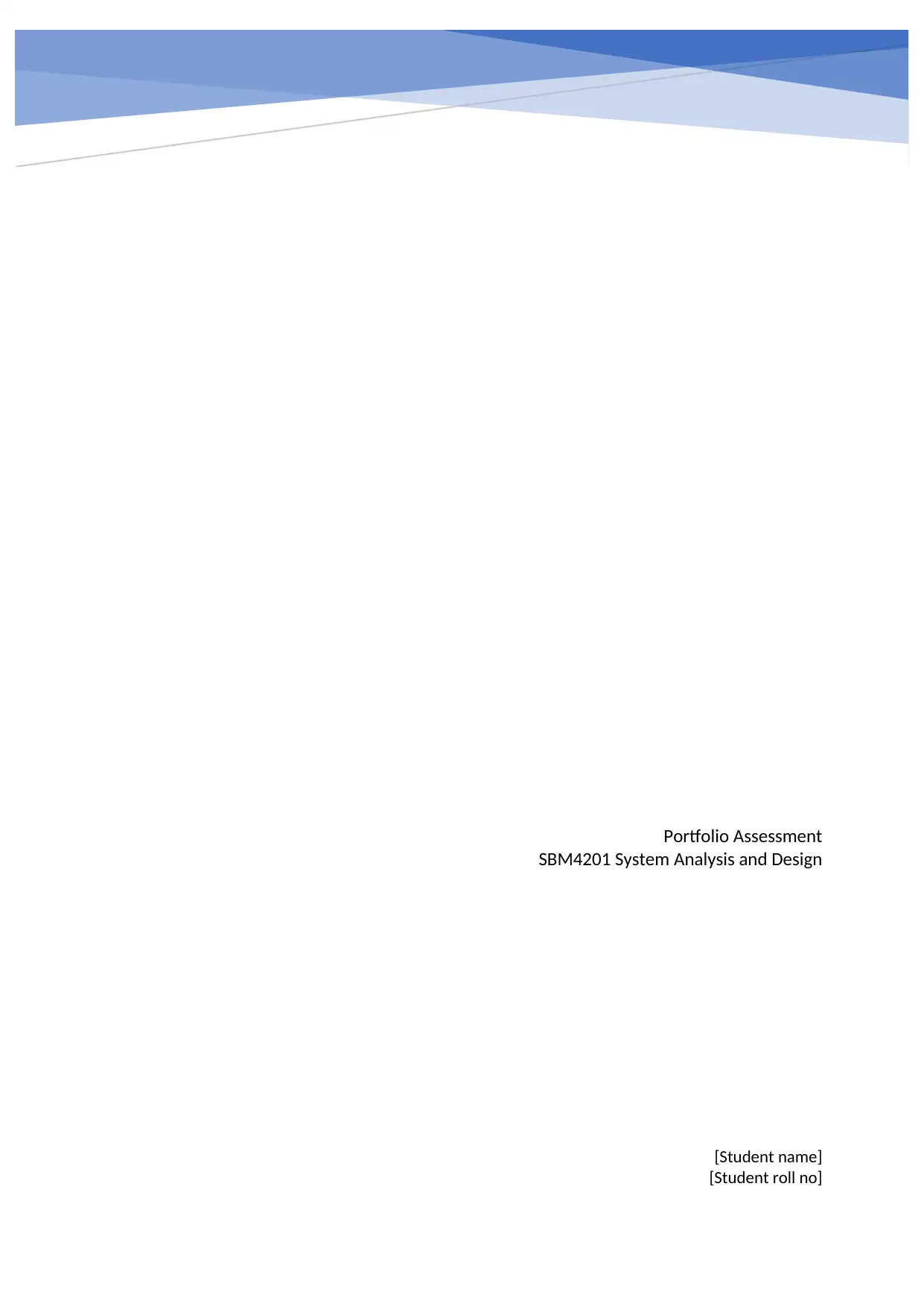
Portfolio Assessment
SBM4201 System Analysis and Design
[Student name]
[Student roll no]
SBM4201 System Analysis and Design
[Student name]
[Student roll no]
Paraphrase This Document
Need a fresh take? Get an instant paraphrase of this document with our AI Paraphraser
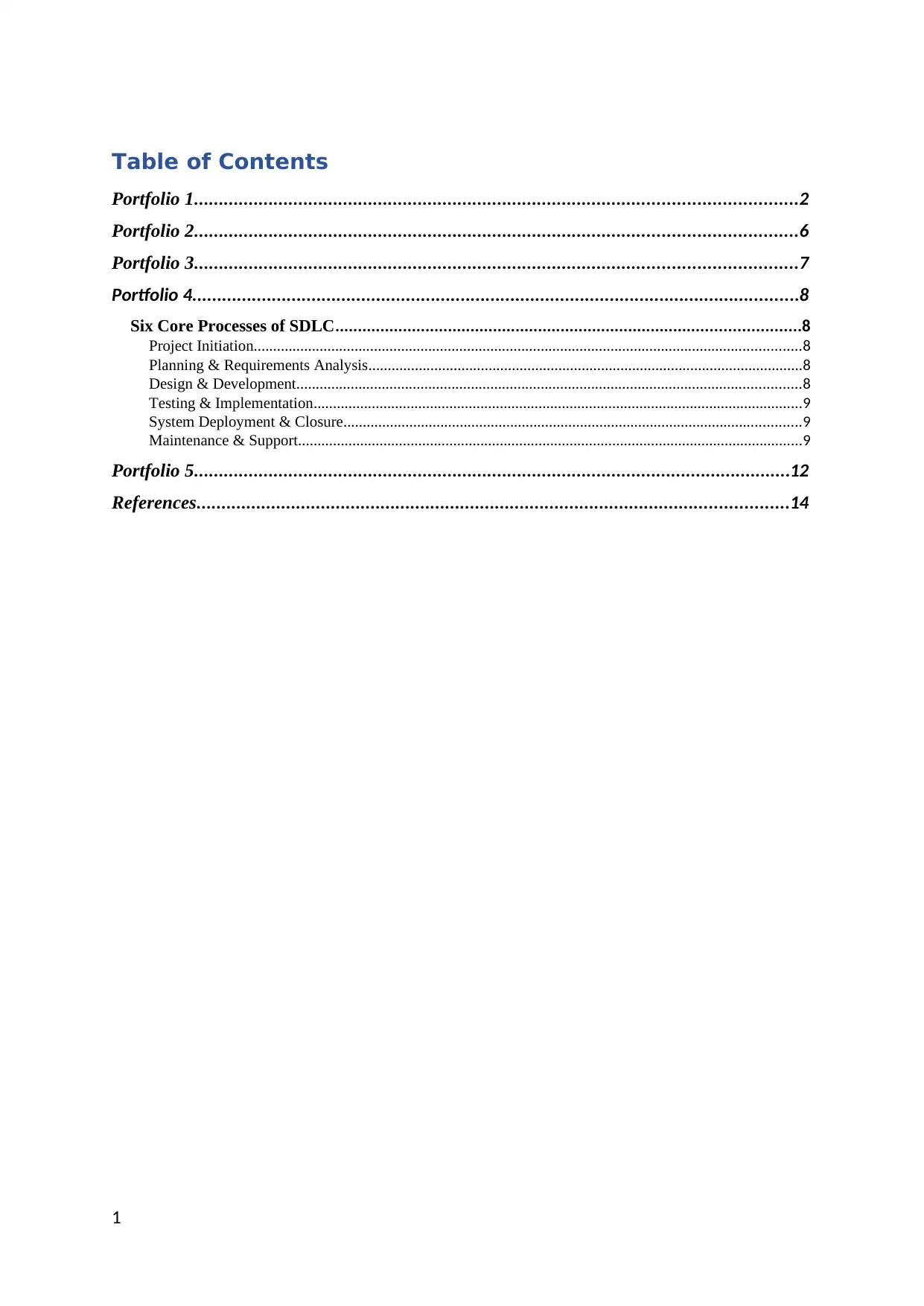
Table of Contents
Portfolio 1.........................................................................................................................2
Portfolio 2.........................................................................................................................6
Portfolio 3.........................................................................................................................7
Portfolio 4..........................................................................................................................8
Six Core Processes of SDLC.......................................................................................................8
Project Initiation.............................................................................................................................................8
Planning & Requirements Analysis................................................................................................................8
Design & Development..................................................................................................................................8
Testing & Implementation..............................................................................................................................9
System Deployment & Closure......................................................................................................................9
Maintenance & Support..................................................................................................................................9
Portfolio 5........................................................................................................................12
References.......................................................................................................................14
1
Portfolio 1.........................................................................................................................2
Portfolio 2.........................................................................................................................6
Portfolio 3.........................................................................................................................7
Portfolio 4..........................................................................................................................8
Six Core Processes of SDLC.......................................................................................................8
Project Initiation.............................................................................................................................................8
Planning & Requirements Analysis................................................................................................................8
Design & Development..................................................................................................................................8
Testing & Implementation..............................................................................................................................9
System Deployment & Closure......................................................................................................................9
Maintenance & Support..................................................................................................................................9
Portfolio 5........................................................................................................................12
References.......................................................................................................................14
1

Portfolio 1
Entities – Following are key entities and their attributes of the proposed student registration
system:
Entity name Attribute
Program programName
programDuration
programStartDate
programFinishDate
Student studentID
studentName
studentAge
studentPhoneNo
studentEmail
Course courseID
courseName
courseStartDate
courserFinishDate
programName
Employee employeeID
SSN
employeeName
employeeAddress
employeePhoneNo
employeeEmail
Desgination
accessPriviledge
Payment paymentID
paymentDate
paymentAmount
PaymentMode
StudentID
programName
courserID
2
Entities – Following are key entities and their attributes of the proposed student registration
system:
Entity name Attribute
Program programName
programDuration
programStartDate
programFinishDate
Student studentID
studentName
studentAge
studentPhoneNo
studentEmail
Course courseID
courseName
courseStartDate
courserFinishDate
programName
Employee employeeID
SSN
employeeName
employeeAddress
employeePhoneNo
employeeEmail
Desgination
accessPriviledge
Payment paymentID
paymentDate
paymentAmount
PaymentMode
StudentID
programName
courserID
2
⊘ This is a preview!⊘
Do you want full access?
Subscribe today to unlock all pages.

Trusted by 1+ million students worldwide
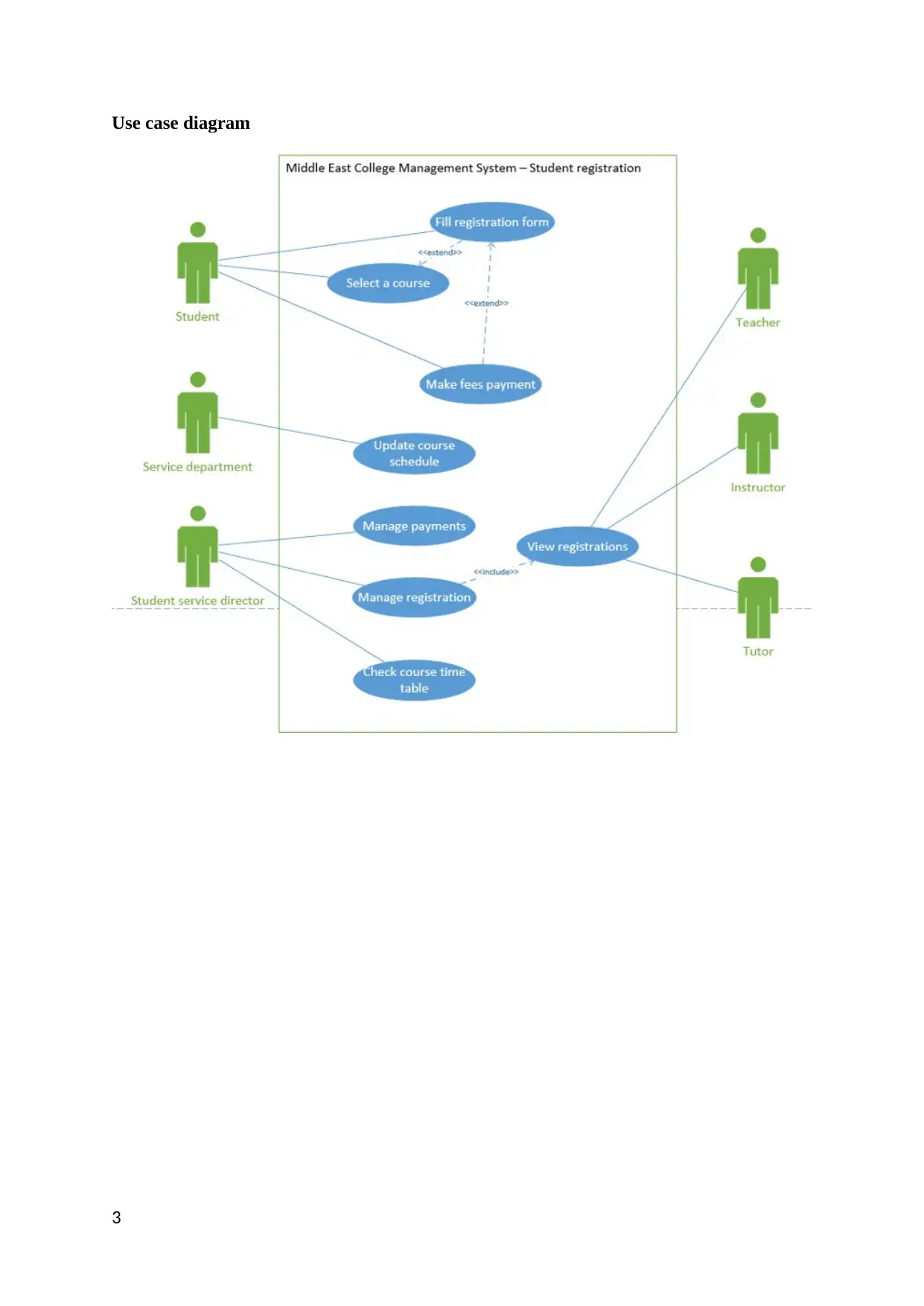
Use case diagram
3
3
Paraphrase This Document
Need a fresh take? Get an instant paraphrase of this document with our AI Paraphraser
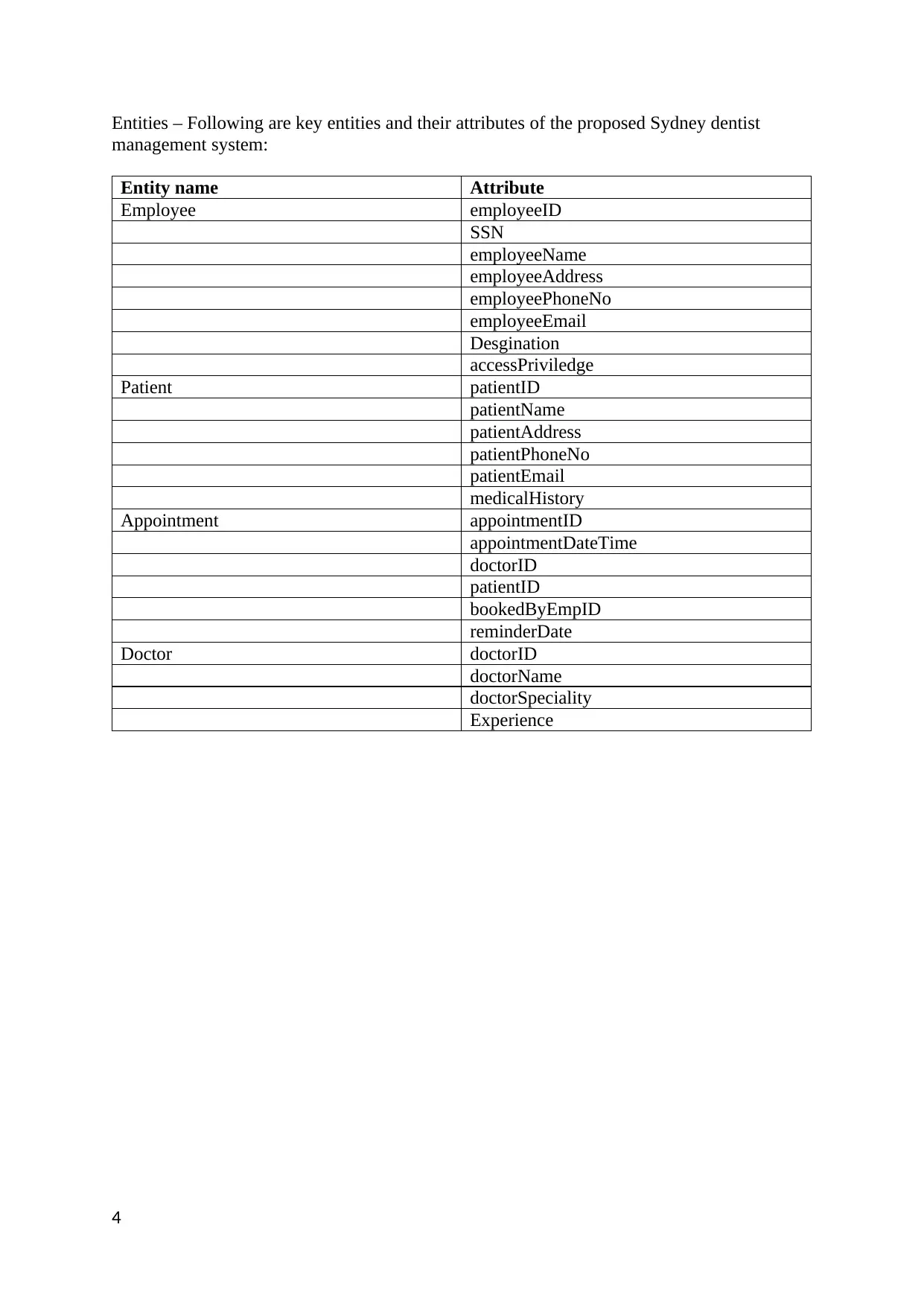
Entities – Following are key entities and their attributes of the proposed Sydney dentist
management system:
Entity name Attribute
Employee employeeID
SSN
employeeName
employeeAddress
employeePhoneNo
employeeEmail
Desgination
accessPriviledge
Patient patientID
patientName
patientAddress
patientPhoneNo
patientEmail
medicalHistory
Appointment appointmentID
appointmentDateTime
doctorID
patientID
bookedByEmpID
reminderDate
Doctor doctorID
doctorName
doctorSpeciality
Experience
4
management system:
Entity name Attribute
Employee employeeID
SSN
employeeName
employeeAddress
employeePhoneNo
employeeEmail
Desgination
accessPriviledge
Patient patientID
patientName
patientAddress
patientPhoneNo
patientEmail
medicalHistory
Appointment appointmentID
appointmentDateTime
doctorID
patientID
bookedByEmpID
reminderDate
Doctor doctorID
doctorName
doctorSpeciality
Experience
4
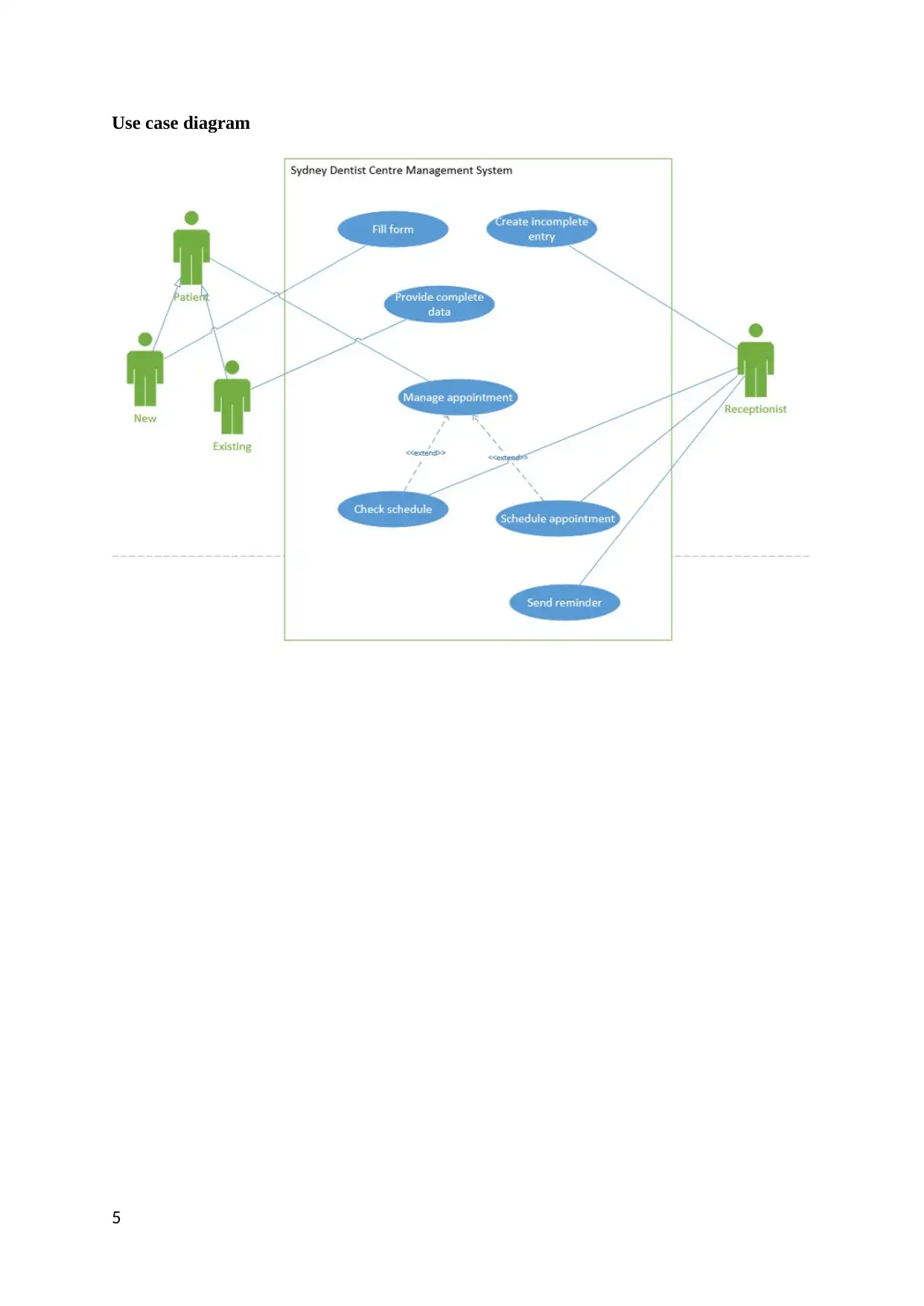
Use case diagram
5
5
⊘ This is a preview!⊘
Do you want full access?
Subscribe today to unlock all pages.

Trusted by 1+ million students worldwide
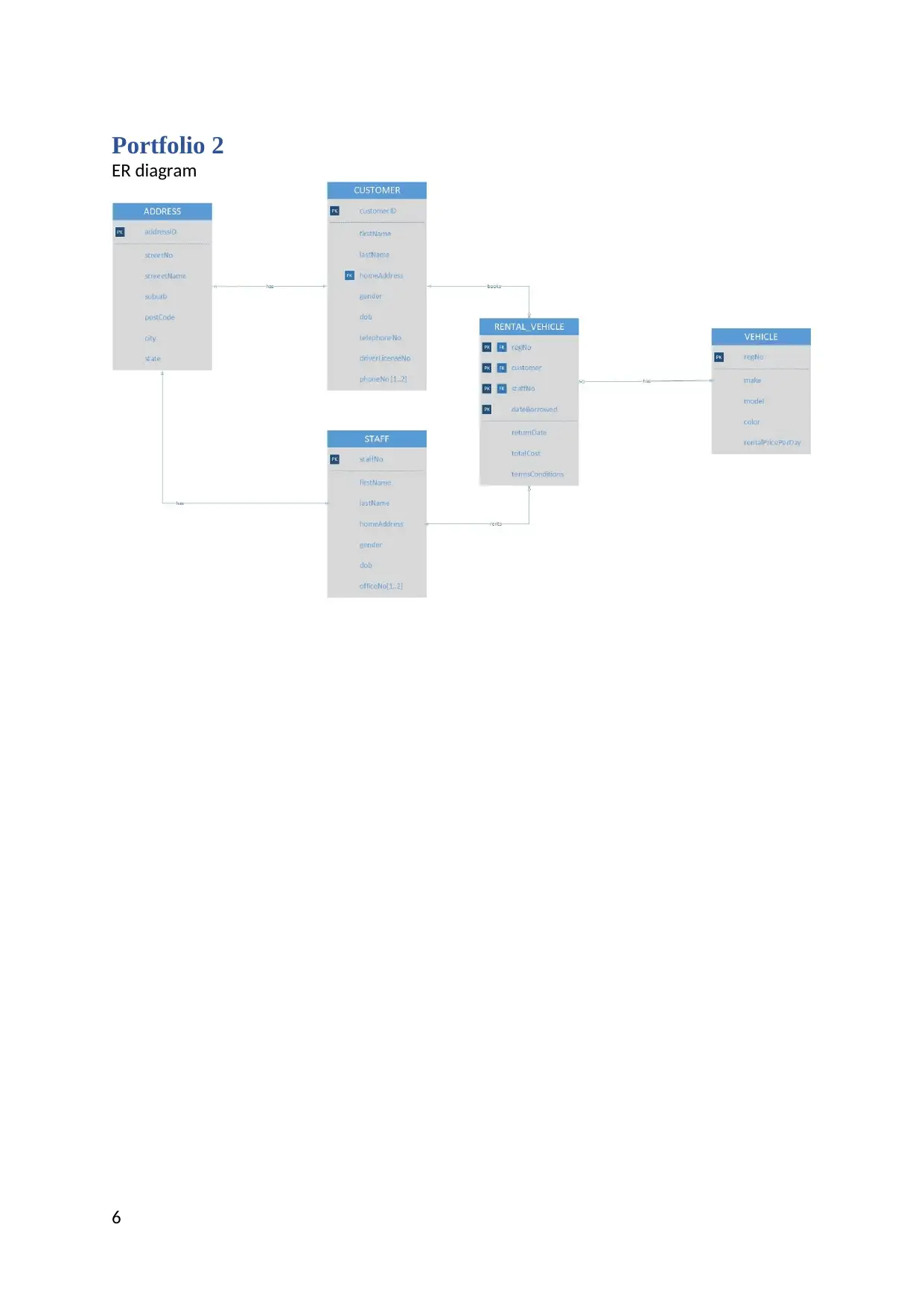
Portfolio 2
ER diagram
6
ER diagram
6
Paraphrase This Document
Need a fresh take? Get an instant paraphrase of this document with our AI Paraphraser

Portfolio 3
Work Breakdown Structure
WBS Task Name Duration Predecessors
1 system design 5 days
2 subsystem A design 5 days 1
3 subsystem B design 4 days 2
4 subsystem C design 5 days 3
5 Program A 9 days 4
6 program B 5 days 4
7 program C 8 days 4
8 Testing 4 days 5,6,7
Critical path
WBS Task Start Date End Date EST EFT LST LFT Slack
1 system design 14-09-2018 19/09/18 0 5 0 5 0
2 subsystem A design 19/09/18 24/09/18 5 10 5 10 0
3 subsystem B design 24/09/18 28/09/18 10 14 10 14 0
4 subsystem C design 28/09/18 03/10/18 14 19 14 19 0
5 Program A 03/10/18 12/10/18 19 28 18 28 0
6 program B 03/10/18 08/10/18 19 24 22 28 4
7 program C 03/10/18 11/10/18 19 27 19 28 1
8 Testing 11/10/18 15/10/18 28 32 28 32 0
All those activities which are having 0 slack, form the critical path i.e. 1 > 2 > 3> 4 > 5 > 8
Work Breakdown Structure
Task Name Duration Predecessor
1 Research 15
2 understanding system requirements 14 1
3 writing algorithms and coding 20 2
4 Debugging and testing 8 3
5 deploying and maintained 5 4
Critical path
Task Name Start Date Finish Date EST EFT LST LFT Slack
1 Research 14-09-2018 29-09-2018 0 15 0 15 0
2 understanding system requirements 29-09-2018 13-10-2018 15 29 15 29 0
3 writing algorithms and coding 13-10-2018 02-11-2018 29 49 29 49 0
4 Debugging and testing 02-11-2018 10-11-2018 49 57 49 57 0
5 deploying and maintained 10-11-2018 15-11-2018 57 62 57 62 0
All those activities which are having 0 slack, form the critical path i.e. 1 > 2 > 3 > 4 > 5
7
Work Breakdown Structure
WBS Task Name Duration Predecessors
1 system design 5 days
2 subsystem A design 5 days 1
3 subsystem B design 4 days 2
4 subsystem C design 5 days 3
5 Program A 9 days 4
6 program B 5 days 4
7 program C 8 days 4
8 Testing 4 days 5,6,7
Critical path
WBS Task Start Date End Date EST EFT LST LFT Slack
1 system design 14-09-2018 19/09/18 0 5 0 5 0
2 subsystem A design 19/09/18 24/09/18 5 10 5 10 0
3 subsystem B design 24/09/18 28/09/18 10 14 10 14 0
4 subsystem C design 28/09/18 03/10/18 14 19 14 19 0
5 Program A 03/10/18 12/10/18 19 28 18 28 0
6 program B 03/10/18 08/10/18 19 24 22 28 4
7 program C 03/10/18 11/10/18 19 27 19 28 1
8 Testing 11/10/18 15/10/18 28 32 28 32 0
All those activities which are having 0 slack, form the critical path i.e. 1 > 2 > 3> 4 > 5 > 8
Work Breakdown Structure
Task Name Duration Predecessor
1 Research 15
2 understanding system requirements 14 1
3 writing algorithms and coding 20 2
4 Debugging and testing 8 3
5 deploying and maintained 5 4
Critical path
Task Name Start Date Finish Date EST EFT LST LFT Slack
1 Research 14-09-2018 29-09-2018 0 15 0 15 0
2 understanding system requirements 29-09-2018 13-10-2018 15 29 15 29 0
3 writing algorithms and coding 13-10-2018 02-11-2018 29 49 29 49 0
4 Debugging and testing 02-11-2018 10-11-2018 49 57 49 57 0
5 deploying and maintained 10-11-2018 15-11-2018 57 62 57 62 0
All those activities which are having 0 slack, form the critical path i.e. 1 > 2 > 3 > 4 > 5
7

Portfolio 4
Six Core Processes of SDLC
Project Initiation
The kick-off meeting would be executed within the team members of the team at CarHire.
The overall estimation of the project has been put up at 1 year and 2 months by the IT
department. Some key areas as well as requirements would be highlighted based on business
case as well as feasibility process would be carried out. In this feasibility analysis process, it
will be based on operational, economic, technical and environmental factors. All results from
these studies would then be compiled and analyzed in Project charter. This document would
include details such as the project highlights, key areas of the project and feasibility studies
(Cohen, Dori & De Haan, 2010).
Planning & Requirements Analysis
The requirement and planning analysis phase would include various fact finding methods as
well as their execution as the very first. These techniques would thereby include various
interviews that will be conducted with CarHire members including customer, employees,
development team, etc. Some other methods that would be deployed will include domain
analysis, group discussions, observations as well as brainstorming. The entire data that will
be collected in this process will then be analyzed in order to ascertain both non-functional
and functional needs of the system. After this, the planning activities will be done which will
include the scope management plan, installation plan of servers, databases and systems.
Among these, the budget estimations as well as schedule estimations would also be
conducted. Communication planning, Risk Planning as well as Quality management would
be based on the resources which will then be distributed to project-based activities (Singh &
Sharma, 2015). Afterwards, a project plan would be developed.
Design & Development
The mobile application would need to be designing by making use of modern responsive
design principles. Also, the mockups for each of such systems would also be prepared by
making use of platforms and tools for the system. A compatibility analysis study will also be
done and further ahead the source-code for each of these systems shall be developed. The
network and database diagram would be done using the front-end systems and then the
system would be released to the team to test it.
8
Six Core Processes of SDLC
Project Initiation
The kick-off meeting would be executed within the team members of the team at CarHire.
The overall estimation of the project has been put up at 1 year and 2 months by the IT
department. Some key areas as well as requirements would be highlighted based on business
case as well as feasibility process would be carried out. In this feasibility analysis process, it
will be based on operational, economic, technical and environmental factors. All results from
these studies would then be compiled and analyzed in Project charter. This document would
include details such as the project highlights, key areas of the project and feasibility studies
(Cohen, Dori & De Haan, 2010).
Planning & Requirements Analysis
The requirement and planning analysis phase would include various fact finding methods as
well as their execution as the very first. These techniques would thereby include various
interviews that will be conducted with CarHire members including customer, employees,
development team, etc. Some other methods that would be deployed will include domain
analysis, group discussions, observations as well as brainstorming. The entire data that will
be collected in this process will then be analyzed in order to ascertain both non-functional
and functional needs of the system. After this, the planning activities will be done which will
include the scope management plan, installation plan of servers, databases and systems.
Among these, the budget estimations as well as schedule estimations would also be
conducted. Communication planning, Risk Planning as well as Quality management would
be based on the resources which will then be distributed to project-based activities (Singh &
Sharma, 2015). Afterwards, a project plan would be developed.
Design & Development
The mobile application would need to be designing by making use of modern responsive
design principles. Also, the mockups for each of such systems would also be prepared by
making use of platforms and tools for the system. A compatibility analysis study will also be
done and further ahead the source-code for each of these systems shall be developed. The
network and database diagram would be done using the front-end systems and then the
system would be released to the team to test it.
8
⊘ This is a preview!⊘
Do you want full access?
Subscribe today to unlock all pages.

Trusted by 1+ million students worldwide

Testing & Implementation
The system which would be made by the development team would then be tested as well as
executed for various activities including integration, security and performance testing. The
overall system reviews as well as inspection of all the project activities will be executed too.
There might be certain alterations that may be needed in the system and these could very well
include resolution of the defects, modification and addition of all the functionality among
others. Any changes that needs to be incorporated at this stage shall be done with the help of
a proper change planning process and the final defect report would be sent to the PM or the
Project Manager (Larim, Albuolayan, Sabaa & Rehman, 2016).
System Deployment & Closure
An ultimate review would then be carried out for the system by technical experts. There
needs to be system documentation prepared for both the learning systems. These
documentations would also include tutorials, manual, system description, guides and FAQs.
The ultimate users of the system which includes faculty members, staff, administration and
users would be provided with adequate training. Lastly, the project deliverables would need
to be signed off by each of the stake holders and the final system shall be delivered to the
end-users (Kaur, 2015).
Maintenance & Support
There needs to be appropriate amount of maintenance support provided by the company in
the form of system updates, patches and maintenance activities. Furthermore, online, on-call
and remote assistance shall also be provided for the system whenever users may face
problems in the form of security issues, system errors and operational issues. Such issues
shall also be recorded, followed-up and resolved at the earliest. Finally, a log of all of the
activities that took place shall be recorded.
9
The system which would be made by the development team would then be tested as well as
executed for various activities including integration, security and performance testing. The
overall system reviews as well as inspection of all the project activities will be executed too.
There might be certain alterations that may be needed in the system and these could very well
include resolution of the defects, modification and addition of all the functionality among
others. Any changes that needs to be incorporated at this stage shall be done with the help of
a proper change planning process and the final defect report would be sent to the PM or the
Project Manager (Larim, Albuolayan, Sabaa & Rehman, 2016).
System Deployment & Closure
An ultimate review would then be carried out for the system by technical experts. There
needs to be system documentation prepared for both the learning systems. These
documentations would also include tutorials, manual, system description, guides and FAQs.
The ultimate users of the system which includes faculty members, staff, administration and
users would be provided with adequate training. Lastly, the project deliverables would need
to be signed off by each of the stake holders and the final system shall be delivered to the
end-users (Kaur, 2015).
Maintenance & Support
There needs to be appropriate amount of maintenance support provided by the company in
the form of system updates, patches and maintenance activities. Furthermore, online, on-call
and remote assistance shall also be provided for the system whenever users may face
problems in the form of security issues, system errors and operational issues. Such issues
shall also be recorded, followed-up and resolved at the earliest. Finally, a log of all of the
activities that took place shall be recorded.
9
Paraphrase This Document
Need a fresh take? Get an instant paraphrase of this document with our AI Paraphraser
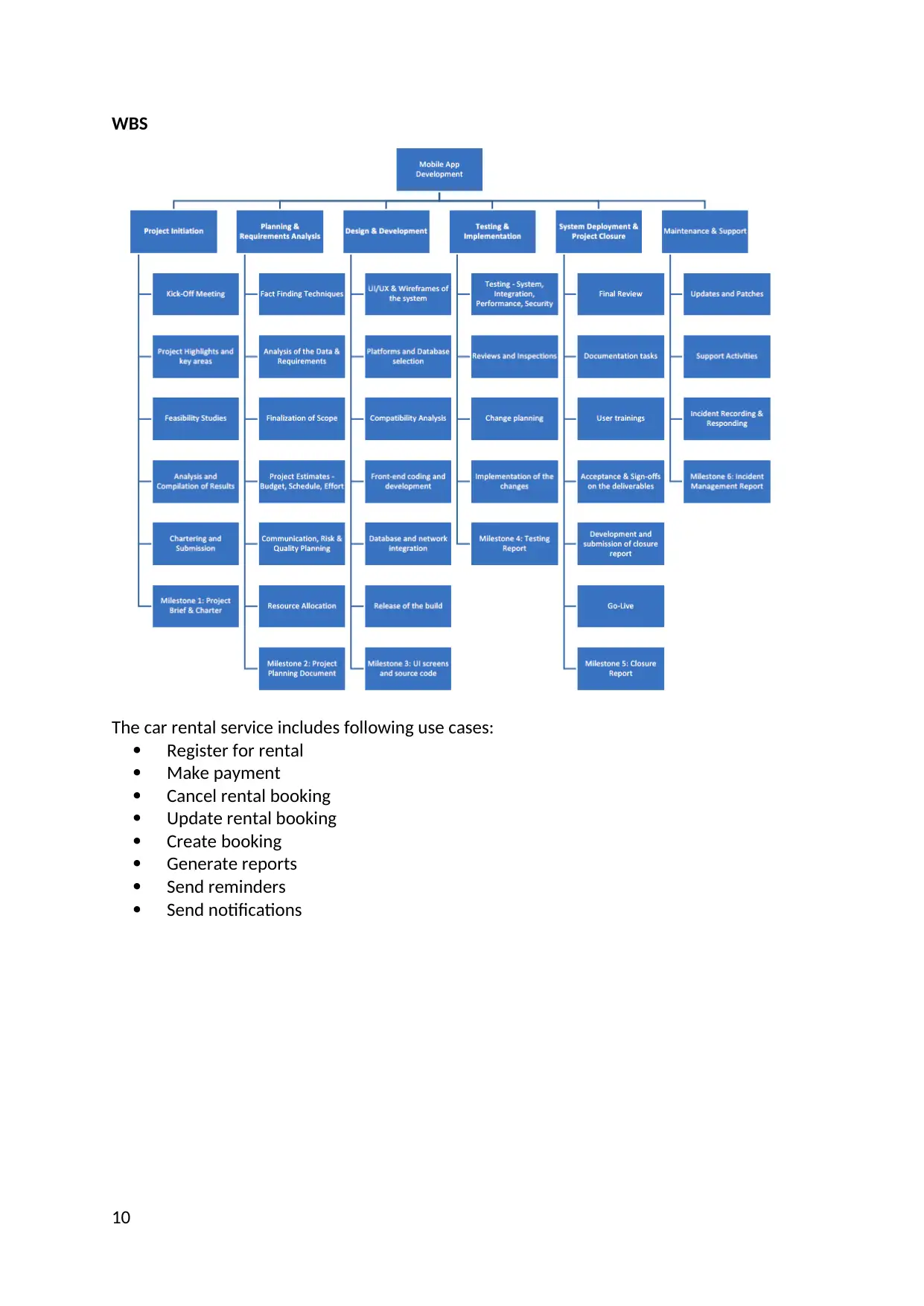
WBS
The car rental service includes following use cases:
Register for rental
Make payment
Cancel rental booking
Update rental booking
Create booking
Generate reports
Send reminders
Send notifications
10
The car rental service includes following use cases:
Register for rental
Make payment
Cancel rental booking
Update rental booking
Create booking
Generate reports
Send reminders
Send notifications
10
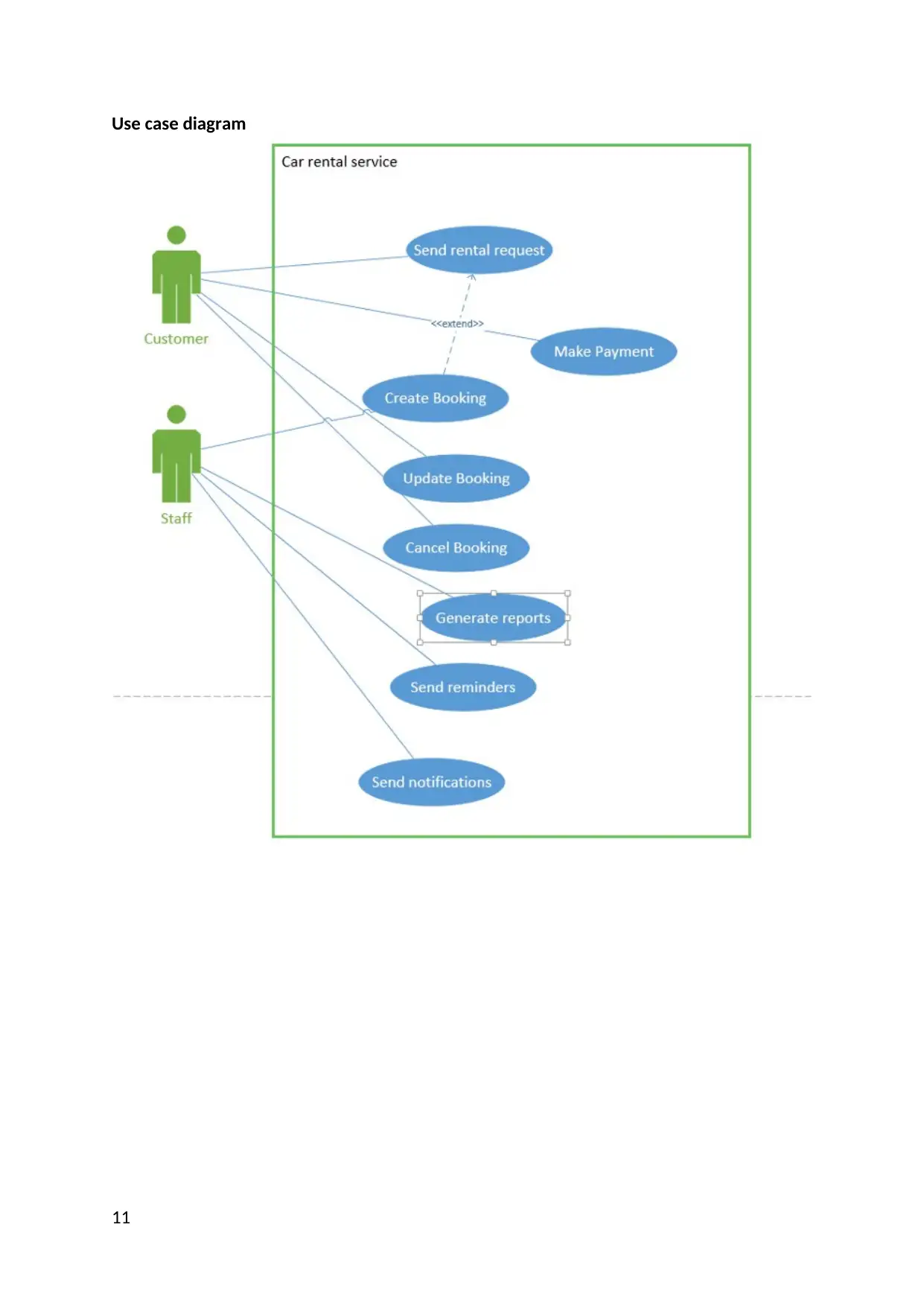
Use case diagram
11
11
⊘ This is a preview!⊘
Do you want full access?
Subscribe today to unlock all pages.

Trusted by 1+ million students worldwide
1 out of 15
Related Documents
Your All-in-One AI-Powered Toolkit for Academic Success.
+13062052269
info@desklib.com
Available 24*7 on WhatsApp / Email
![[object Object]](/_next/static/media/star-bottom.7253800d.svg)
Unlock your academic potential
Copyright © 2020–2025 A2Z Services. All Rights Reserved. Developed and managed by ZUCOL.




